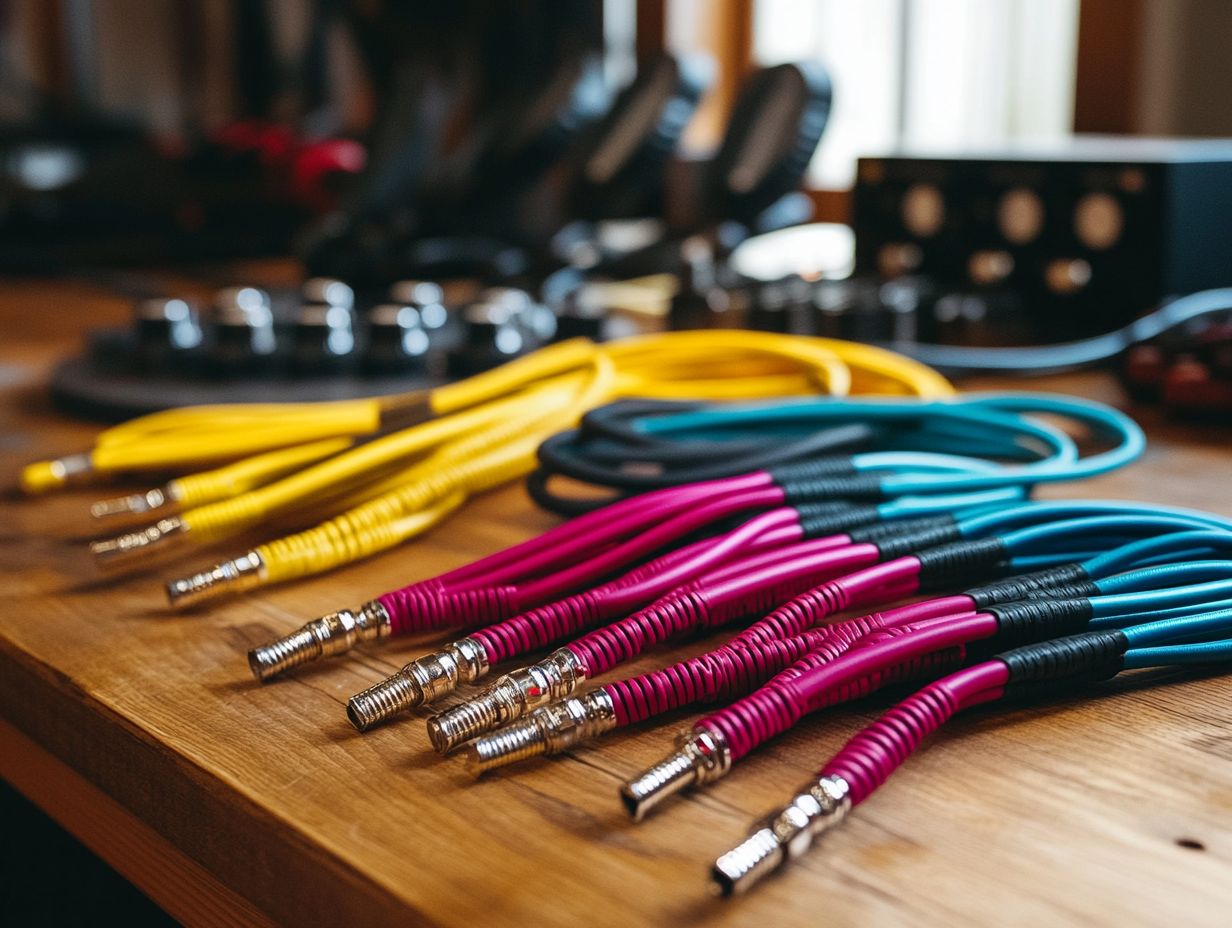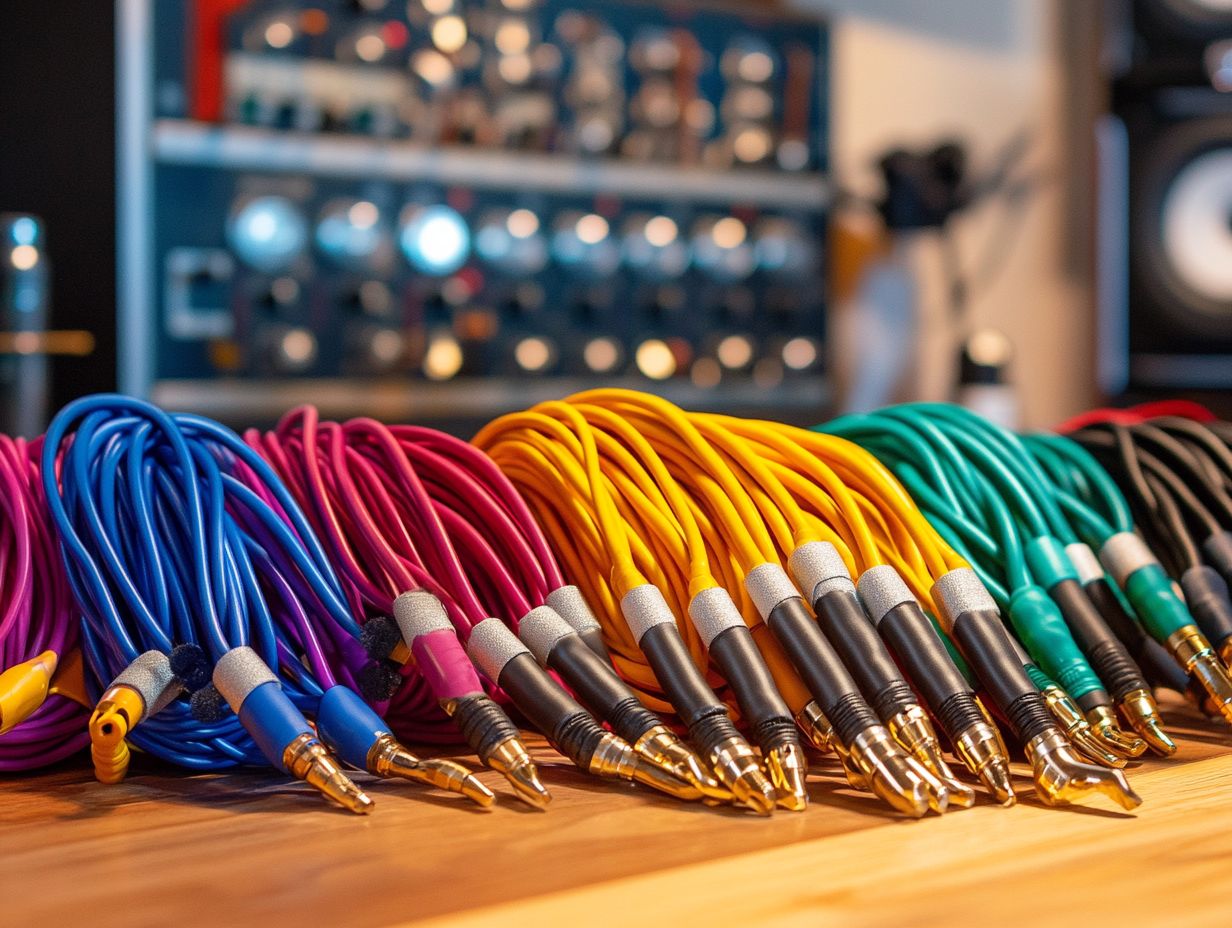In the field of audio production, the significance of high-quality cables is frequently overlooked; however, they are essential for achieving optimal sound quality.
Understanding the different types of cables used in studios and recognizing the characteristics that distinguish superior options are crucial for selecting the appropriate cables, as this choice can markedly affect the quality of recordings.
This guide will provide key considerations, maintenance recommendations, and alternative options, ensuring that informed decisions are made regarding your studio setup.
Prepare to enhance your audio capabilities.
Understanding Studio Cables

A comprehensive understanding of studio cables is essential for any audio engineer or music producer aiming to create high-quality recordings.
In the field of professional audio, various types of cables play critical roles in ensuring that sound is transmitted with exceptional clarity and integrity.
From XLR cables utilized for microphones to TRS and patch cables used for instruments, the appropriate selection of cables can significantly influence the overall sound quality.
It is not merely a matter of connectivity; rather, it involves choosing high-performance cables that are compatible with the studio setup while minimizing signal loss and noise interference.
Types of Cables Used in Studios
In professional studios, a diverse range of cables is utilized to connect equipment and facilitate audio transmission, with each type serving a specific function. Among the most prevalent are XLR cables, which provide reliable balanced connections for microphones, and TRS cables, commonly employed for instruments and line-level signals.
Patch cables offer flexible routing between devices, and the choice between balanced and unbalanced cables can significantly impact noise performance and overall sound clarity within a recording setup.
Balanced cables, such as XLR and TRS, are engineered to minimize interference and preserve audio integrity by employing two signal wires along with a shield. This design makes them particularly suitable for long-distance runs within a studio environment.
Conversely, unbalanced cables, which typically consist of a single wire and shield, are more vulnerable to noise and are best utilized for short connections, such as between a guitar and an amplifier.
The specifications of these cables, including their gauge and shielding, determine their performance under various conditions, directly influencing the final outcome during recording and mixing sessions.
Qualities of High-Quality Cables
High-quality cables are essential for achieving optimal audio performance in any studio environment.
The construction of these cables incorporates materials that enhance both durability and flexibility, while also minimizing noise interference during sound transmission.
Key factors such as cable shielding and gold-plated connectors significantly contribute to maintaining signal integrity and reducing potential distortion.
A comprehensive understanding of these attributes enables sound engineers to select the most suitable cables for their studio setups, ultimately improving recording quality and sound clarity.
Materials and Construction
The materials and construction of studio cables play a crucial role in determining their performance and longevity. High-performance cables typically employ robust materials designed to withstand wear and tear, thereby ensuring durability across various studio environments.
Features such as effective cable shielding and gold-plated connectors enhance electrical conductivity and minimize interference, which contributes to superior sound transmission and clarity.
Among the most commonly utilized materials are oxygen-free copper and high-quality plastics, both recognized for their resistance to corrosion and adverse environmental factors. Oxygen-free copper, in particular, improves signal quality by reducing resistance, enabling clearer audio reproduction.
Additionally, the choice of insulation significantly influences performance; foam and polymer options provide excellent dielectric properties that help maintain signal integrity.
The inclusion of strong, flexible outer jackets protects against abrasion and stretching, rendering these durable cables suitable for both studio and live applications.
Interference and Noise Reduction

Interference and noise reduction are critical factors to consider when selecting cables for studio applications. Low-noise cables are specifically engineered to minimize noise interference, thereby preserving the true sound quality of audio during both recording and playback.
Additionally, effective cable management and routing can enhance performance by preventing signal loss and ensuring clean audio transmission between devices.
To attain optimal sound quality, it is important to examine various factors, such as the choice of shielding and connector types. High-quality shielding materials can effectively block electromagnetic interference, which often contributes to background noise, while robust connectors enhance signal integrity.
Moreover, implementing proper grounding techniques and avoiding excessive exposure to potential interference sources are essential practices in audio setups. By prioritizing these considerations, individuals can establish a more reliable environment that facilitates clearer and more precise sound reproduction, ultimately elevating the overall audio experience.
Choosing the Right Cables for Your Studio
Selecting the appropriate cables for your studio is crucial for attaining optimal sound quality and ensuring compatibility with your studio equipment.
Factors such as cable length and gauge significantly influence signal integrity and must be taken into account during the selection process.
Furthermore, a comprehensive understanding of the specific requirements of your gear, including studio monitors, mixing consoles, and audio interfaces, will aid in the selection of high-quality cables that enhance the overall performance of your studio.
Factors to Consider
When selecting cables for a studio environment, several critical factors must be evaluated to ensure optimal connectivity and performance. The length of the cable can significantly influence signal loss, while the gauge determines the cable’s capacity to transmit audio signals without degradation.
Additionally, impedance matching is essential for maintaining audio fidelity, and the overall reliability of the cables can have a substantial impact on recording quality and studio performance.
The type of connectors utilized is also a vital consideration in ensuring a secure and noise-free connection. Inferior quality connectors may introduce unwanted interference, compromising sound clarity.
Furthermore, it is important to assess the materials used in the cable’s construction. High-quality shielding is necessary to prevent external electromagnetic interference, which is particularly crucial in a studio setting.
Flexibility and durability should not be overlooked, as cables that are susceptible to wear and tear or are difficult to manage can result in frustrating disruptions during recording sessions.
By carefully considering these factors—cable reliability, impedance, and overall build quality—creators can achieve a seamless and high-quality audio experience.
Proper Care and Maintenance of Studio Cables
The proper care and maintenance of studio cables are essential for extending their lifespan and ensuring consistent performance in audio production.
Implementing effective cable management techniques can minimize wear and tear, while regular inspections can help identify potential issues before they develop into more significant problems.
Furthermore, utilizing high-quality cables specifically designed for studio use enhances reliability and reduces the need for frequent replacements, which is crucial for any serious audio engineer or music producer.
Tips for Prolonging Lifespan

To extend the lifespan of studio cables, it is essential to implement effective cable maintenance and management practices. Utilizing cable wraps and organizing coiled cables can prevent tangling and reduce strain on connectors. Additionally, investing in heavy-duty cables that can withstand the demands of frequent studio use is advisable.
Regular inspections of cables for signs of wear and damage are also critical to maintaining their functionality.
Proper organization of cables through dedicated storage solutions can significantly enhance their longevity. Employing cable ties to secure lengths without constricting or crimping will help minimize wear. It is also prudent to avoid placing heavy equipment on top of cables, as this can lead to internal damage.
Labeling different types of cables can simplify setup and teardown processes, ensuring that each cable remains in good condition. By adopting a proactive approach and incorporating these practical tips, one can foster an environment where studio cables are treated with care, ultimately prolonging their lifespan.
Alternatives to High-Quality Cables
High-quality cables are frequently recommended for optimal audio transmission and sound fidelity; however, there are alternative options that can effectively address specific needs within a studio environment.
Custom cables, for instance, can be designed to meet particular requirements, offering efficient solutions at a lower cost compared to high-end cables.
Furthermore, the use of various studio accessories can enhance the existing setup and improve overall performance.
Other Options for Studio Setups
When evaluating alternatives for studio setups, custom cables and performance cables offer distinct advantages tailored to specific audio requirements. These options facilitate personalized configurations that enhance compatibility with various studio equipment and audio interfaces.
Investigating different cable brands can provide alternative solutions that accommodate a range of budgets while maintaining acceptable audio quality.
Custom cables are particularly beneficial as they can be designed to meet the precise needs of any project, thereby ensuring optimal signal integrity and minimizing interference. For instance, performance cables frequently incorporate superior shielding and connectors, which can significantly enhance sound clarity during recordings and live performances.
These high-grade options not only improve the overall audio experience but also offer durability and reliability, which are essential in professional settings. By investing in specialized cables, engineers and producers can achieve a more streamlined workflow, enabling them to concentrate on creativity without being hindered by technical limitations.
Frequently Asked Questions
What are high-quality cables for studio use?

High-quality cables for studio use are specialized audio cables that are designed to provide the clearest, most accurate signal transmission possible. They are typically used in recording studios, music production facilities, and other professional audio settings.
Why are high-quality cables important for studio use?
High-quality cables are important for studio use because they can greatly impact the overall sound quality of your recordings. They are specifically designed to minimize interference and distortion, resulting in cleaner, more accurate audio.
What types of high-quality cables are available for studio use?
There are several types of high-quality cables available for studio use, including XLR cables, TRS cables, and RCA cables. Each type is designed for a specific purpose and can be used for different audio equipment.
How do I know if a cable is high-quality?
There are a few key factors to look for when determining if a cable is high-quality. These include the material and construction of the cable, the connectors used, and any shielding or insulation that helps reduce interference.
Can I use regular cables for studio use?
Regular cables may work for basic audio needs, but they are not recommended for studio use. High-quality cables have specific features that make them more suitable for professional audio settings, such as better shielding and more durable construction.
Are high-quality cables for studio use expensive?
High-quality cables can range in price, but they are typically more expensive than regular cables. However, the investment is worth it for the improved sound quality and durability they provide. Plus, they can save you money in the long run by preventing the need for frequent replacements.


 Enhance Your Music with Top Portable Audio Recorders
Enhance Your Music with Top Portable Audio Recorders